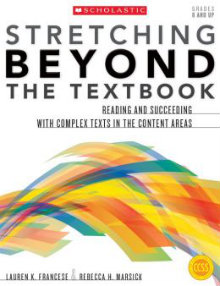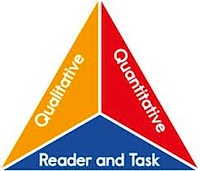Student Choice: MINDful Reading in Content Areas
Stretching Beyond the Textbook: Reading and Succeeding with Complex Texts in the Content Areas
By Lauren K. Francese and Rebecca H. Marsick
(Scholastic, 2014 – Learn more)

In Stretching Beyond the Textbook: Reading and Succeeding with Complex Texts in the Content Areas, Lauren K. Francese and Rebecca H. Marsick propose a framework for reading nonfiction texts in different content areas: MINDful reading.
MINDful reading allows students to make deep and Meaningful connections, as well as Interdisciplinary connections with Nonfiction texts that promote Dialogue among students. The MINDful reading strategy is one way to promote the idea that all teachers are teachers of reading.

- Give students ownership of their reading,
- Promote dialogue between and among peers,
- Connect classroom learning to various content goals,
- Provide explicit strategies for reading comprehension, and
- Differentiate instruction.
Francese is a social studies teacher, and Marsick is a literacy coach with more than a decade of experience teaching in middle and high school ELA classrooms. Although most of the book’s focus is history and social studies, the authors make the case that the MINDful reading approach is a good match for any content-heavy subject.
Reshaping your reading approach
The common model in most classrooms is to have every student read the same book and conduct whole group discussions. The authors flip that model and propose different ways content-area teachers can use several texts that will not only engage students, but help them understand the most salient facts about a topic.
Students can either read one book as a class, or be split up into smaller book groups since a broad focus question is guiding the discussion and unit in the classroom. Students can be grouped by ability level or by book choice. Heterogeneous groups will require teacher differentiation that can be accomplished by providing students with different content, different processes to use while reading, or different products in which students display their learning. One of the benefits of MINDful reading is that students are able to discuss with others and observe what strategies other students in the classroom are using, which they in turn can use to improve their own thinking and comprehension skills.
(Download samples from the book, including an appendix showing suggested texts for three history units)
One of the most critical aspects for adolescents is choice – they need choice in what they are reading. Choice increases engagement, motivation, and independence. In MINDful reading, students get to choose the nonfiction text they read from a list of books that center around a theme. The authors suggest that when selecting texts, it is okay to choose texts that may be above students’ reading levels. When students are engaged and interested in the content of the reading, they are more willing to challenge themselves.

Using different types of nonfiction texts allows students to see how this type of reading will be applicable to their life outside of school.
What the book offers
This short text walks teachers through how to develop a MINDful unit from the beginning (conceptualizing a focus question to guide the study) all the way to the end (administering and assessing students’ culminating dialogue).
During the planning process, one of the most fundamental steps is to determine why students will be reading a particular nonfiction text. Once this is determined, teachers can set clear goals and focus questions to guide instruction. Focus questions are different from content questions because they are universal, which allows students to bring their life experiences and multiple perspectives into the classroom.
Teachers need to set a clear purpose for reading and ask students to reflect on this. This process of reflection will make the purpose for reading much more clear. Additionally, the authors propose ways that focus questions can be used across the curriculum, creating interdisciplinary units for middle school teachers.
The Appendix includes a list of suggested texts that can be used as a whole class text or student-selected texts to go with social studies units on World War II, Civil Rights, Lincoln, the Space Race, and Human Rights/Global Studies. Also included are various graphic organizers students can use before, during, and after reading; directions for how to conduct small group meetings; sample close reading passages for texts in the various units; dialogue preparation sheets; guided reflection questions; and a MINDful Unit planner.
Stretching Beyond the Textbook provides several realistic ways to structure the classroom around discussion and nonfiction texts; however, the book’s examples are centered around the middle school social studies classroom. The MINDful reading model can easily be adapted to other content areas, but if you are looking for materials in those areas that you can immediately implement in your classroom, you may have to keep looking.
Abbey Graham is a PhD student in Curriculum and Instruction in Literacy and Language Arts at North Carolina State University. Before returning to school full time, she taught high school English in Colorado. Her main research interests are struggling readers, disciplinary literacy, and teachers’ beliefs about literacy instruction. Her webpage is a work in progress, where she provides links to past presentations, book summaries for YA and classic works of literature, as well as various resources for classroom teachers.


































